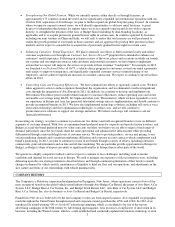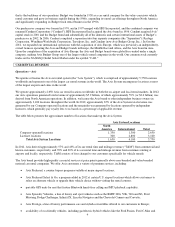Avis 2012 Annual Report Download - page 20
Download and view the complete annual report
Please find page 20 of the 2012 Avis annual report below. You can navigate through the pages in the report by either clicking on the pages listed below, or by using the keyword search tool below to find specific information within the annual report.13
for 2012 and can vary from year to year based on the prices at which we are able to purchase and dispose of rental vehicles.
In 2012, on average approximately 46% of our rental car fleet was comprised of vehicles subject to agreements requiring
automobile manufacturers to repurchase them or guarantee the depreciation rate for a specified period of time, or vehicles
subject to operating leases. We refer to such agreements as “programs” and to cars subject to such agreements as “program
cars.” Under these programs, automobile manufacturers agree to repurchase cars at a specified price during a specified time
period or guarantee the rate of depreciation for a specified period of time, typically subject to certain car condition and
mileage requirements. These programs therefore enable us to determine, in advance, our depreciation expense, which is a
significant component of our fleet costs. These programs also limit the risk to us that the market value of a car, at the time of
its disposition, will be less than its estimated residual (or depreciated) value; however, as discussed below, such programs
result in additional exposure to the manufacturers with whom we have such agreements.
Automobile manufacturers may not continue to sell program cars to us at all or on terms consistent with past practice. The
overall cost of program cars could also increase if the manufacturers were to make changes to such programs, particularly if
such changes were to result in an adverse impact in the repurchase price or guaranteed depreciation without a corresponding
decrease to the original purchase price. Programs also generally provide us with flexibility to reduce the size of our fleet
rapidly in response to seasonal demand fluctuations, an economic slowdown or other changes in demand by disposing of cars
sooner than originally expected. This flexibility may be reduced in the future to the extent that we reduce the percentage of
program cars in our car rental fleet or features of the programs are altered.
We receive payments from manufacturers, known as “incentive payments,” once certain contractual conditions are met,
such as reaching certain purchase volumes. Our per-unit fleet costs could increase if we should decide to purchase fewer
vehicles than previously agreed, or if we do not meet volume requirements or if incentive payments are reduced or
eliminated by manufacturers. Any increase in our per-unit fleet costs could adversely impact our financial condition and
results of operations.
We face risks related to the financial condition of automobile manufacturers and the used vehicle marketplace.
Approximately 21%, 18% and 12% of the cars we acquired for our fleet in 2012 were manufactured by Ford, General Motors
and Chrysler, respectively. A majority of these cars and a portion of cars purchased from other manufacturers for our fleet are
program cars. If a manufacturer were to default under its agreements with us as a result of bankruptcy proceedings or
otherwise, we could incur material expenses if the prices at which we were able to dispose of program cars were less than the
specified prices under the applicable program. This effect could be magnified because we typically pay manufacturers more
for a program car than we would pay for the same car as a non-program vehicle, which we refer to as a “risk vehicle,” and
because we depreciate a program car to the repurchase price or the guaranteed depreciation agreed to by the manufacturer.
This agreed price does not vary with conditions in the marketplace and is usually higher than the price that would be
available in the used car marketplace. We also receive incentive payments from manufacturers following the purchase of
some of our vehicles once certain conditions are met, such as reaching certain purchase volumes. Failure by a manufacturer
to fulfill its obligations under any program agreement or incentive payment obligation could leave us with a substantial
unpaid claim against the manufacturer, particularly with respect to program cars that were either (i) resold for an amount less
than the amount guaranteed under the applicable program and therefore subject to a “true-up” payment obligation from the
manufacturer or (ii) returned to the manufacturer but for which we were not yet paid, and therefore we could incur a
substantial loss as a result of such failure to perform.
We currently sell non-program vehicles through auctions, third-party resellers and other channels in the used vehicle
marketplace. Such channels may not produce stable used vehicle prices. A reduction in residual values for non-program cars
and trucks in our vehicle rental fleet could cause us to sustain a substantial loss on the ultimate sale of such vehicles or
require us to depreciate those vehicles at a more accelerated rate while we own them.
Any reduction in the market value of the vehicles in our fleet could effectively increase our fleet costs, adversely impact our
profitability and potentially lead to decreased capacity in our asset-backed car rental funding facilities due to the collateral
requirements for such facilities which effectively increase as market values for vehicles decrease. In addition, if our ability to
sell vehicles in the used vehicle marketplace were to become severely limited at a time when required collateral levels were
rising, principal under our asset-backed financing facilities may be required to be repaid sooner than anticipated with vehicle
disposition proceeds and lease payments we make to our vehicle program subsidiaries. If that were to occur, the holders of
our asset-backed debt may have the ability to exercise their right to instruct the trustee to direct the return of program vehicles
and/or the sale of non-program vehicles to generate proceeds sufficient to repay such debt.
























